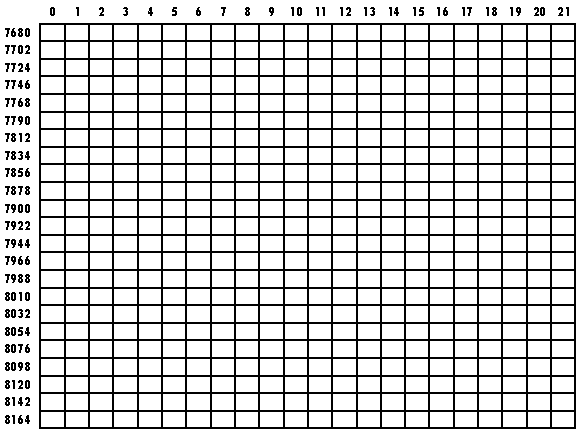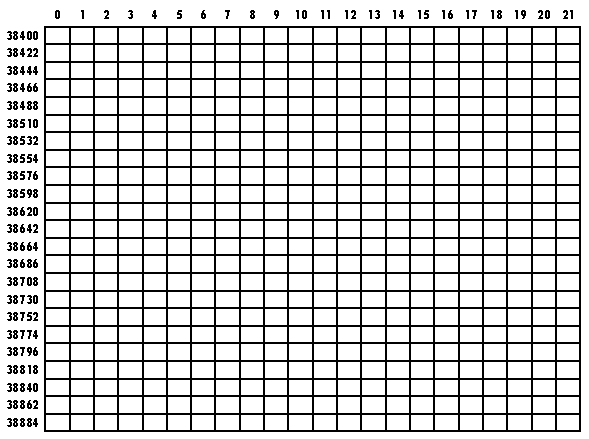Difference between revisions of "Memory Map"
Jump to navigation
Jump to search
| (6 intermediate revisions by the same user not shown) | |||
| Line 1: | Line 1: | ||
| − | |||
| − | |||
| − | |||
| − | |||
The VIC-20's 6502 Microprocessor can directly address 64KB of memory. | The VIC-20's 6502 Microprocessor can directly address 64KB of memory. | ||
| Line 11: | Line 7: | ||
The memory map is divided in 8 '''blocks''', each 8K in length, and numbered 0 to 7. | The memory map is divided in 8 '''blocks''', each 8K in length, and numbered 0 to 7. | ||
| − | == [[1KB Low Memory|1 KB low Memory]] RAM (built-in) | + | <span style="float:left; margin-top:4px;">__TOC__</span> |
| + | [[File:Memory Map.png|thumb|right|600px| | ||
| + | {| | ||
| + | |- | ||
| + | |style="background-color:red;"| ||Onboard RAM||style="background-color:#00B7EF;"| ||Expansion port||style="background-color:#22B14C;"| ||Onboard ROM | ||
| + | |- | ||
| + | |style="background-color:violet;"| ||I/O chips||style="background-color:orange;"| ||Color RAM||style="background-color:yellow;"| ||Expansion Port I/O | ||
| + | |}]] | ||
| + | {{clear}} | ||
| + | =Memory map= | ||
| + | == Block 0 == | ||
| + | === [[1KB Low Memory|1 KB low Memory]] RAM (built-in) === | ||
* $0000-$00FF: Zeropage | * $0000-$00FF: Zeropage | ||
| Line 17: | Line 24: | ||
* $0200-$03FF: KERNAL and BASIC working areas | * $0200-$03FF: KERNAL and BASIC working areas | ||
| − | == 3 KB open area in Block 0 == | + | === 3 KB open area in Block 0 === |
* $0400-$07FF: 1 KB, accessed by <span style="text-decoration: overline">RAM1</span> line | * $0400-$07FF: 1 KB, accessed by <span style="text-decoration: overline">RAM1</span> line | ||
| Line 23: | Line 30: | ||
* $0C00-$0FFF: 1 KB, accessed by <span style="text-decoration: overline">RAM3</span> line | * $0C00-$0FFF: 1 KB, accessed by <span style="text-decoration: overline">RAM3</span> line | ||
| − | == 4 KB Main RAM (built-in) in Block 0 == | + | === 4 KB Main RAM (built-in) in Block 0 === |
* $1000-$1FFF: 4 KB, Main RAM | * $1000-$1FFF: 4 KB, Main RAM | ||
| − | == 8 KB Expansion Blocks | + | == Blocks 1-3: 8 KB Expansion Blocks == |
* $2000-$3FFF: 8 KB, Expansion Block 1, accessed by <span style="text-decoration: overline">BLK1</span> line | * $2000-$3FFF: 8 KB, Expansion Block 1, accessed by <span style="text-decoration: overline">BLK1</span> line | ||
| Line 33: | Line 40: | ||
* $6000-$7FFF: 8 KB, Expansion Block 3, accessed by <span style="text-decoration: overline">BLK3</span> line | * $6000-$7FFF: 8 KB, Expansion Block 3, accessed by <span style="text-decoration: overline">BLK3</span> line | ||
| − | == 4 KB ROM | + | == Block 4== |
| + | === 4 KB [[Character ROM]]s === | ||
| + | * $8000-$83FF: 1 KB uppercase/glyphs | ||
| + | * $8400-$87FF: 1 KB uppercase/lowercase | ||
| + | * $8800-$8BFF: 1 KB inverse uppercase/glyphs | ||
| + | * $8C00-$8FFF: 1 KB inverse uppercase/lowercase | ||
| − | + | === 4 KB I/O Blocks === | |
| + | ==== I/O Block 0: VIC/VIA chips ==== | ||
* $9000-$900F: [[Video Interface Chip|VIC]] Registers | * $9000-$900F: [[Video Interface Chip|VIC]] Registers | ||
* $9110-$911F: [[Versatile Interface Adapter|VIA]] #1 Registers | * $9110-$911F: [[Versatile Interface Adapter|VIA]] #1 Registers | ||
* $9120-$912F: VIA #2 Registers | * $9120-$912F: VIA #2 Registers | ||
| − | * $9130-$93FF: Unused< | + | * $9130-$93FF: Unused<SUP><SMALL>'''[A]'''</SMALL></SUP> |
| − | * $9400-$97FF: Color RAM (1K of 4 bit nibbles)< | + | |
| + | ==== I/O Block 1: Color RAM ==== | ||
| + | * $9400-$97FF: [[Color RAM]] (1K of 4 bit nibbles)<SUP><SMALL>'''[B]'''</SMALL></SUP> | ||
| + | |||
| + | ==== I/O Blocks 2-3: Expansion port ==== | ||
* $9800-$9BFF: 1 KB, I/O Expansion 2, accessed by <span style="text-decoration: overline">I/O2</span> line | * $9800-$9BFF: 1 KB, I/O Expansion 2, accessed by <span style="text-decoration: overline">I/O2</span> line | ||
* $9C00-$9FFF: 1 KB, I/O Expansion 3, accessed by <span style="text-decoration: overline">I/O3</span> line | * $9C00-$9FFF: 1 KB, I/O Expansion 3, accessed by <span style="text-decoration: overline">I/O3</span> line | ||
| − | == 8 KB Expansion Area | + | == Block 5: 8 KB Expansion Area == |
| − | * $A000-$BFFF: 8 KB, Expansion Block 5, accessed by <span style="text-decoration: overline">BLK5</span> line. Often used for ROM cartridges. Allows autostart sequence. | + | * $A000-$BFFF: 8 KB, Expansion Block 5, accessed by <span style="text-decoration: overline">BLK5</span> line. Often used for ROM cartridges. Allows [[autostart]] sequence. |
| − | == | + | == Blocks 6 and 7: System ROMs == |
* $C000-$DFFF: 8 KB, Block 6, BASIC Interpreter ROM | * $C000-$DFFF: 8 KB, Block 6, BASIC Interpreter ROM | ||
* $E000-$FFFF: 8 KB, Block 7, KERNAL ROM | * $E000-$FFFF: 8 KB, Block 7, KERNAL ROM | ||
| + | ** The top six bytes of the entire memory space are special to the [[MOS Technology 6502|6502]]. They form three pairs which contain <abbr title="16-bit memory addresses to which the processor jumps">vectors</abbr>: | ||
| + | *** 65530–65531/$FFFA–$FFFB: [[Non-maskable interrupt]] | ||
| + | *** 65532–65533/$FFFC–$FFFD: Reset vector; contains the address where the processor will start running on boot | ||
| + | *** 65534–65535/$FFFE–$FFFF: [[Interrupt request]] | ||
=Screen memory map= | =Screen memory map= | ||
| Line 65: | Line 86: | ||
[[Image: Unexp Vic-20 Screen Colour Codes.png]] | [[Image: Unexp Vic-20 Screen Colour Codes.png]] | ||
| + | = Notes = | ||
| + | <SMALL> | ||
| + | {| | ||
| + | |- | ||
| + | |style="vertical-align:top;"|A.||This memory range actually repeats the memory windows of the VIC and VIA chips. This is due to the VIC-20's physical design. The entire 1k region of $9000-$9400 sits on a chip select line, but when this line is active, only address lines A0-A3 are connected to the chips, and lines A4-A5 are decoded to select from the three chips. Ergo, $9130-$913F map to nothing (decoder output is unused), $9140-$914F maps to the VIC, $9150-$195F to VIA #1, etc. | ||
| + | |- | ||
| + | |style="vertical-align:top;"|B.||Color is mapped to $9400-95FF or $9600-$97FF depending upon a setting in the VIC registers. Typically, it is $9600-$97FF on an unexpanded or 3k expanded VIC, otherwise it is at $9400-95FF. | ||
| + | |} | ||
| + | </SMALL> | ||
[[Category:Programming]] | [[Category:Programming]] | ||
Latest revision as of 15:30, 26 June 2020
The VIC-20's 6502 Microprocessor can directly address 64KB of memory.
A stock VIC-20 has 5K RAM, and 20K ROM built-in. Furthermore 4K of the address range access I/O devices, including the VIC chip. The I/O area also contains 1K of 4-bit values serving as Color RAM.
A range of 256 bytes, with the base address also divisible by 256 is called a page.
The memory map is divided in 8 blocks, each 8K in length, and numbered 0 to 7.
Memory map
Block 0
1 KB low Memory RAM (built-in)
- $0000-$00FF: Zeropage
- $0100-$01FF: CPU Stack
- $0200-$03FF: KERNAL and BASIC working areas
3 KB open area in Block 0
- $0400-$07FF: 1 KB, accessed by RAM1 line
- $0800-$0BFF: 1 KB, accessed by RAM2 line
- $0C00-$0FFF: 1 KB, accessed by RAM3 line
4 KB Main RAM (built-in) in Block 0
- $1000-$1FFF: 4 KB, Main RAM
Blocks 1-3: 8 KB Expansion Blocks
- $2000-$3FFF: 8 KB, Expansion Block 1, accessed by BLK1 line
- $4000-$5FFF: 8 KB, Expansion Block 2, accessed by BLK2 line
- $6000-$7FFF: 8 KB, Expansion Block 3, accessed by BLK3 line
Block 4
4 KB Character ROMs
- $8000-$83FF: 1 KB uppercase/glyphs
- $8400-$87FF: 1 KB uppercase/lowercase
- $8800-$8BFF: 1 KB inverse uppercase/glyphs
- $8C00-$8FFF: 1 KB inverse uppercase/lowercase
4 KB I/O Blocks
I/O Block 0: VIC/VIA chips
- $9000-$900F: VIC Registers
- $9110-$911F: VIA #1 Registers
- $9120-$912F: VIA #2 Registers
- $9130-$93FF: Unused[A]
I/O Block 1: Color RAM
- $9400-$97FF: Color RAM (1K of 4 bit nibbles)[B]
I/O Blocks 2-3: Expansion port
- $9800-$9BFF: 1 KB, I/O Expansion 2, accessed by I/O2 line
- $9C00-$9FFF: 1 KB, I/O Expansion 3, accessed by I/O3 line
Block 5: 8 KB Expansion Area
- $A000-$BFFF: 8 KB, Expansion Block 5, accessed by BLK5 line. Often used for ROM cartridges. Allows autostart sequence.
Blocks 6 and 7: System ROMs
- $C000-$DFFF: 8 KB, Block 6, BASIC Interpreter ROM
- $E000-$FFFF: 8 KB, Block 7, KERNAL ROM
- The top six bytes of the entire memory space are special to the 6502. They form three pairs which contain vectors:
- 65530–65531/$FFFA–$FFFB: Non-maskable interrupt
- 65532–65533/$FFFC–$FFFD: Reset vector; contains the address where the processor will start running on boot
- 65534–65535/$FFFE–$FFFF: Interrupt request
- The top six bytes of the entire memory space are special to the 6502. They form three pairs which contain vectors:
Screen memory map
Following is the memory map for the default screen on an unexpanded Vic 20:
Screen Character Codes
Screen Colour Codes
Notes
| A. | This memory range actually repeats the memory windows of the VIC and VIA chips. This is due to the VIC-20's physical design. The entire 1k region of $9000-$9400 sits on a chip select line, but when this line is active, only address lines A0-A3 are connected to the chips, and lines A4-A5 are decoded to select from the three chips. Ergo, $9130-$913F map to nothing (decoder output is unused), $9140-$914F maps to the VIC, $9150-$195F to VIA #1, etc. |
| B. | Color is mapped to $9400-95FF or $9600-$97FF depending upon a setting in the VIC registers. Typically, it is $9600-$97FF on an unexpanded or 3k expanded VIC, otherwise it is at $9400-95FF. |


